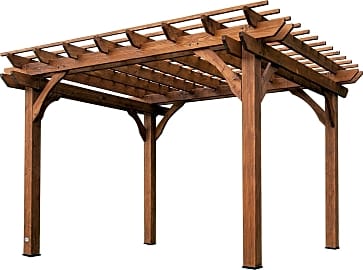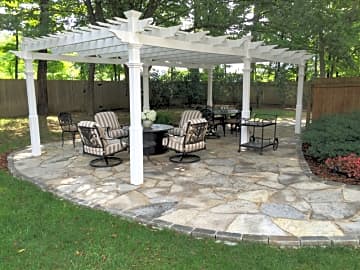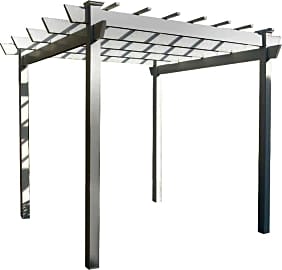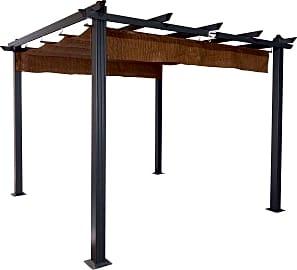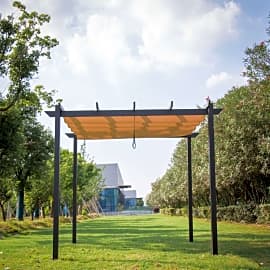The 8 Best Pergolas

This wiki has been updated 38 times since it was first published in January of 2017. Few structures or outdoor decorations can enhance the ambiance of a garden like a quality pergola. They are more than a source of shade or protection from the weather, as they foster a natural gathering place, where climbing plants have the freedom to grow and people can socialize comfortably. They provide overhead coverage using fabric canopies or sturdy panels made from wood or vinyl. When users buy our independently chosen editorial choices, we may earn commissions to help fund the Wiki.
Editor's Notes
October 15, 2019:
A pergola can help to provide shelter from the sun or create an attractive focal point in your garden. Add in some patio furniture, and you’ll have a relaxing backyard oasis for entertaining or kicking back after a long day of work. Our list features models made from wood or vinyl, with either hard panels or fabric canopies to provide shelter and shade from the sun.
One option that provides shelter via attractive louvered panels is the newly added New England Arbors Avalon. The panels can be angled to provide shade exactly where you want it, and it can be mounted either in the ground (using pressure-treated lumber sold separately) or installed on a hard surface like your deck or patio (via brackets sold separately by New England Arbors).
For an option with a fabric canopy, look to the Coolaroo Aurora, which joins our list as an option that can block up to 90% of ultraviolet rays and has been approved by the Melanoma International Foundation. It’s available in your choice of three attractive color options: Mocha, Terracotta, or Smoke.
Leaving the list is the Sunjoy Large Naples, which is no longer available at this time.
Special Honors
Sebastopol Pergola You can create an outdoor great room, dining room, or a large covering over your pool with a Sebastopol Pergola, which is handcrafted from redwood. For this custom piece, a design engineer will send you detailed drawings after you have listed your desired specifications. It’s made from real wood and steel, with notched joints so it won’t sag, warp, twist, or shrink. The timbers are finely sanded for a silky, smooth finish. What's more, you can purchase it with confidence, thanks to its 30-year decay warranty. foreverredwood.com
Country Lane Gazebos These wooden pergolas are made of pressure-treated lumber and will add a rich, traditional look and feel to your backyard. It can be painted or stained in cedar, canyon brown, mahogany, cinder, white, or almond and constructed in a size that’s just right for your outdoor space. Features can be added including a privacy wall, a lattice roof, and a superior post. gazebo.com
A Standalone Gateway To Backyard Bliss
Most of these materials offer superior stability and durability for withstanding extreme weather conditions over extended periods of time.
When you want to add a touch of elegance and architectural creativity to an ordinary backyard or garden environment, you'll need to find something that is both easy on the eyes and capable of bringing people together in a natural setting. One excellent way to accomplish these tasks is to erect a high-quality pergola on your property.
Expanding on the concept of a garden arbor, the pergola is a square or rectangular-shaped freestanding outdoor structure that forms a shaded walkway, passageway, or seating area that is designed to accentuate both open and enclosed space in an unobtrusive way. A pergola typically consists of several vertical posts that support a series of ceiling crossbeams and lattice panels on which flowering vines or other vegetation may be grown for the purpose of sculpting the available space into something that is calming and inviting to those who spend time within it. The structure essentially provides a focal point for one's garden, drawing the attention of guests and family to an intimate place that is an extension of home. Unlike an arbor's design that often includes its own wooden bench chair, the pergola is significantly larger and does not have any built-in seating as part of its overall construction.
Pergolas are classified into gabled and flat-roofed types. The gable roof pergola features angled rafters that come together at a ridge, while the flat-roof (or Skillion) pergola has a slightly-leveled ceiling. Due to its raised design, the gable roof pergola allows for increased airflow, while the sloped sides are capable of reflecting more sunlight than its flat-roofed counterpart. However, the flat-roofed pergola has a design that is less susceptible to damage from extreme winds, making it an ideal choice for placement in areas prone to cyclones, tornadoes, or hurricanes.
Pergolas are available in a variety of materials, the most common of which include untreated woods such as cedar or pine, vinyl, aluminum, and steel. Most of these materials offer superior stability and durability for withstanding extreme weather conditions over extended periods of time.
So, what are some of the advantages that set the pergola apart from other types of outdoor shelters? Firstly, its freestanding design makes it very easy to customize. Equipped with a combination of posts, latticework, and ceiling crossbeams, the structure provides a blank canvas from which planters and weather-resistant fabrics may be hung as a form of artistic expression. This ultimately creates a stylish, yet intimate and private setting that ensures protection from the elements, something an ordinary patio can't do as easily on its own.
Furthermore, the pergola minimizes the need for any complicated installations on one's property, making the building of the structure a great project for the do-it-yourself homeowner on a tight budget. Next, the pergola helps to maximize one's outdoor living space. Although seating doesn't come standard with the structure, chairs and loungers are easy enough to place underneath it. Constructing a pergola from scratch also affords a homeowner the freedom to choose its location and determine how much sun the structure will provide to guests. Obviously, this depends on the season and time of day it's being used.
Creating A Unique Focus In Your Garden
When investing in a pergola, there are several factors to consider, one of the most important elements being your overall surroundings. Think about the types of weather patterns common to your geographical location. Before positioning the pergola and choosing between a gabled or flat-roofed structure, make note of where the sun sets and rises on your property, the shape of your garden, and the typical wind patterns. All of these things will help you determine the optimal building location. Additionally, if you experience seasons with drastic temperature changes and heavy winds, a flat-roofed pergola will be an ideal choice, particularly one made from wood, vinyl, or steel and capable of withstanding the elements. A steel pergola is also a great option when hanging heavy linens from its posts, as the heavy-duty construction will keep these accessories in place.
A steel pergola is also a great option when hanging heavy linens from its posts, as the heavy-duty construction will keep these accessories in place.
Next, think about the structure's purpose and how it can transform your home. Will you be using the pergola for privacy or entertaining? If it's the latter, a more elaborate design with extra roof coverage will come in handy, particularly if you plan to use the space for an outdoor barbecue.
Finally, consider the type of vegetation you might like to grow on your pergola, especially when wowing your guests with visual appeal is a top priority. Common plants like Virginia Creeper, Wisteria, Dutchman`s Pipe, and Hydrangea are popular in most modern gardens and will add an aesthetic flare to almost any style of pergola.
A Brief History Of Pergolas
The oldest surviving garden plan including the pergola dates back to 1400 BCE and was rumored to be a plant archway belonging to an Egyptian high court official of Thebes. The main reasoning behind the pergola's creation remains unknown, but common belief suggests it was formed for aesthetic reasons or due to the influences of weather.
This design continued well into the 19th and 20th centuries.
Over the centuries, the pergola remained important as a symbol of social status for the elite and a practical tool for growing vegetation. The word pergola is derived from the Latin word “pergula”, which refers to a “projecting eave”. The term was first used in the 1640s by John Evelyn at the cloister of Trinita dei Monti in Rome. Around the same time, inhabitants of Eastern Asia began creating their own pergolas with curved beams that emulated the arched architecture of their pagodas.
By the late Italian Renaissance in the 17th century, use of the pergola became popular as a display of beauty, often featuring smooth stone pillars that were large and dramatic. This design continued well into the 19th and 20th centuries. Modern pergolas are made from combinations of wood, vinyl, and fiberglass, as these materials are durable and easy to maintain. Their simplicity and functionality are likely to stand the test of time.


